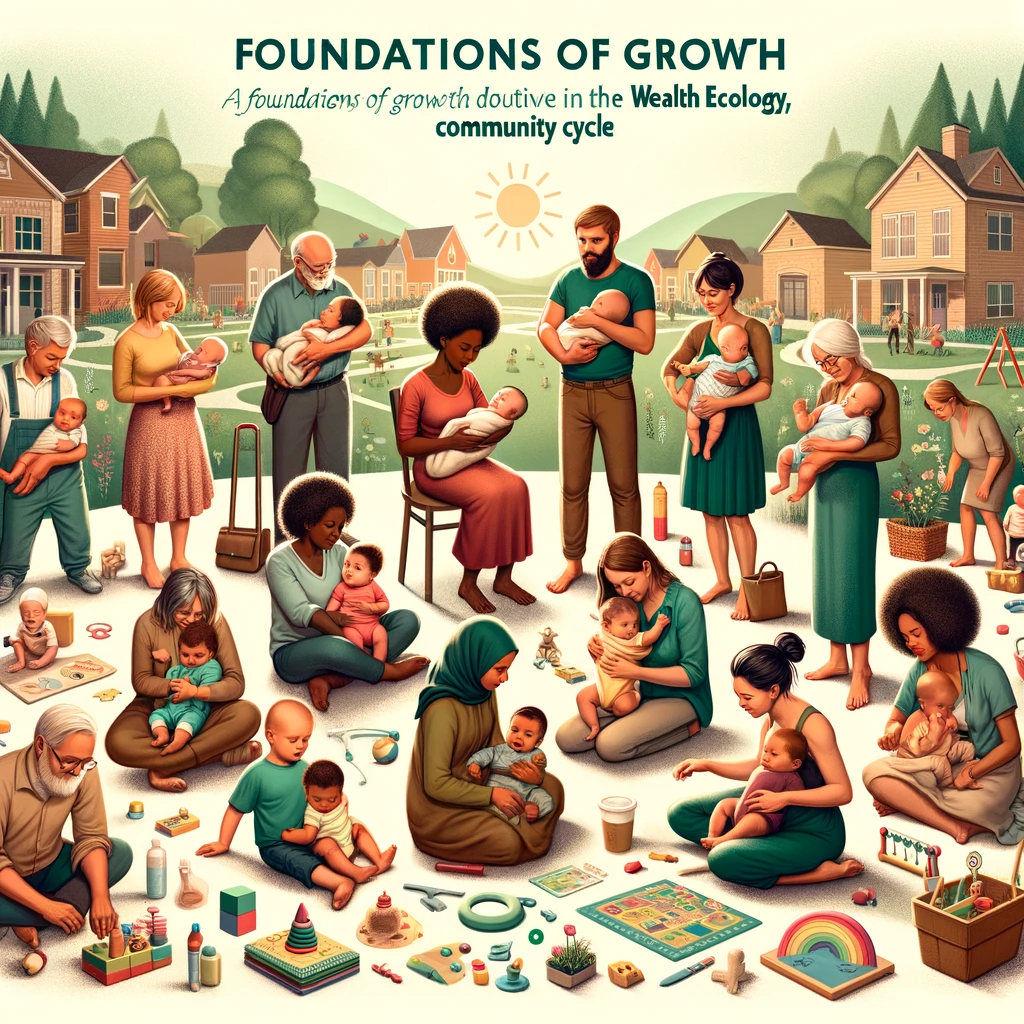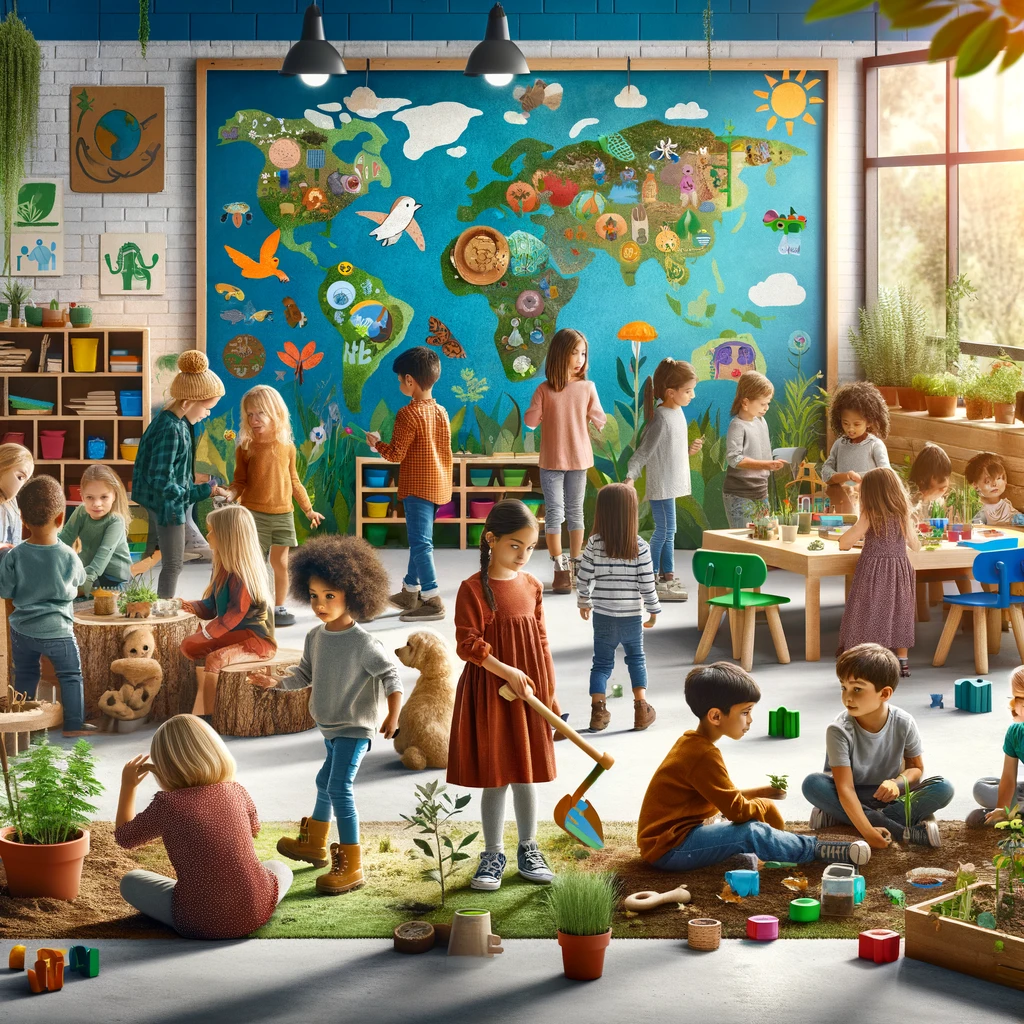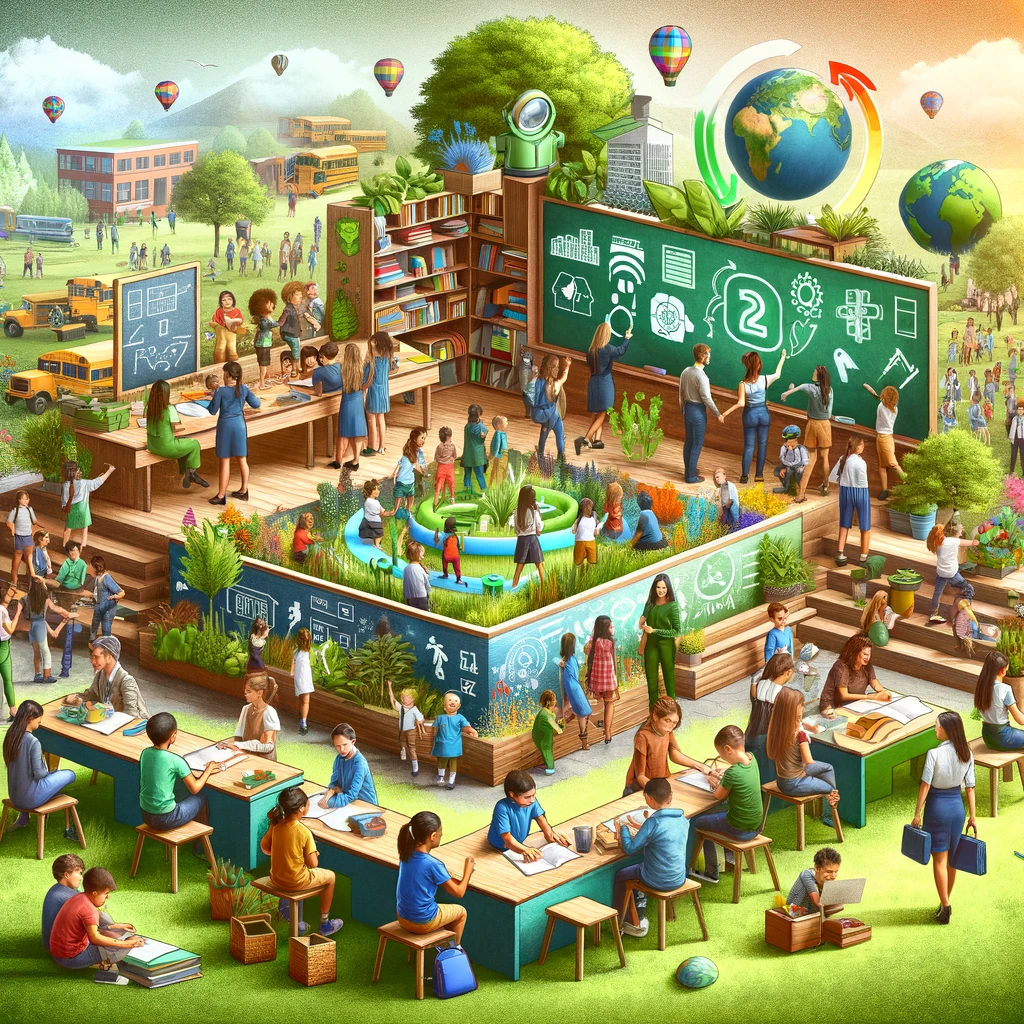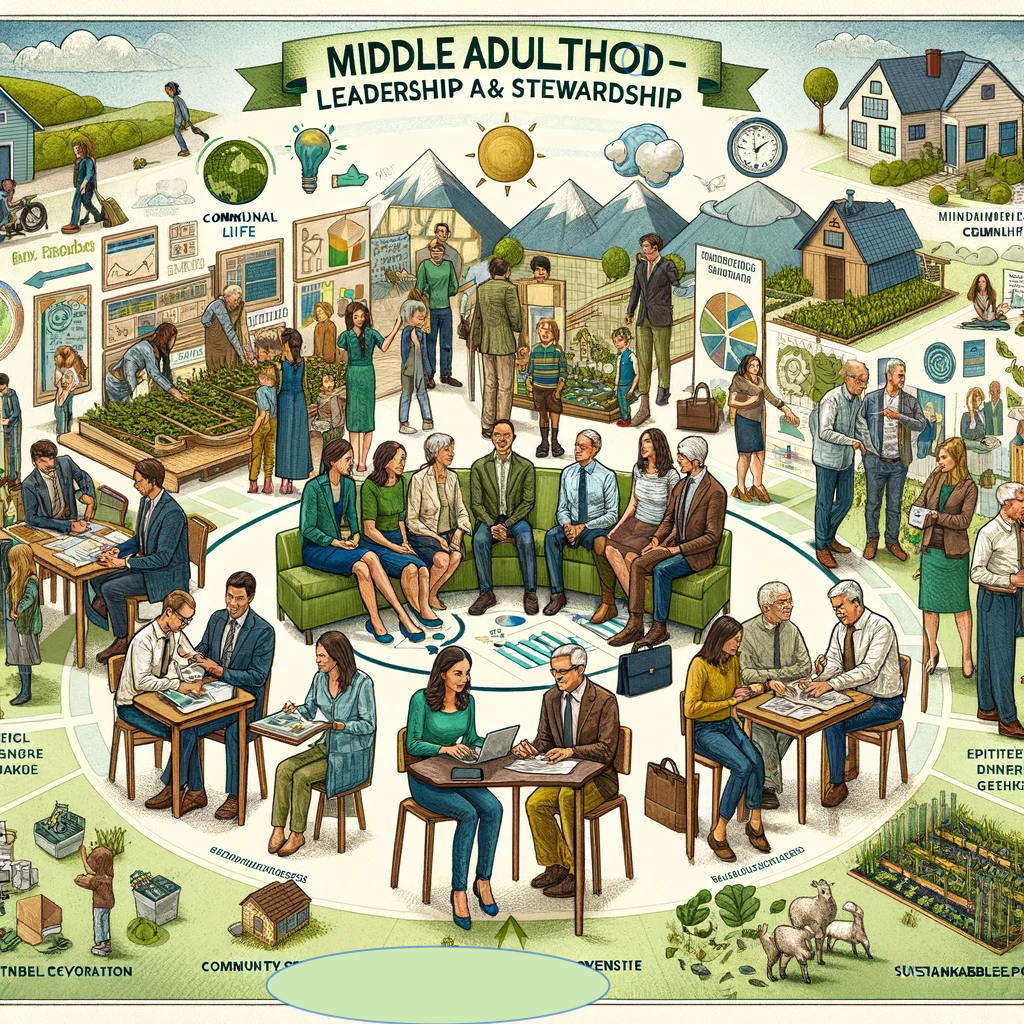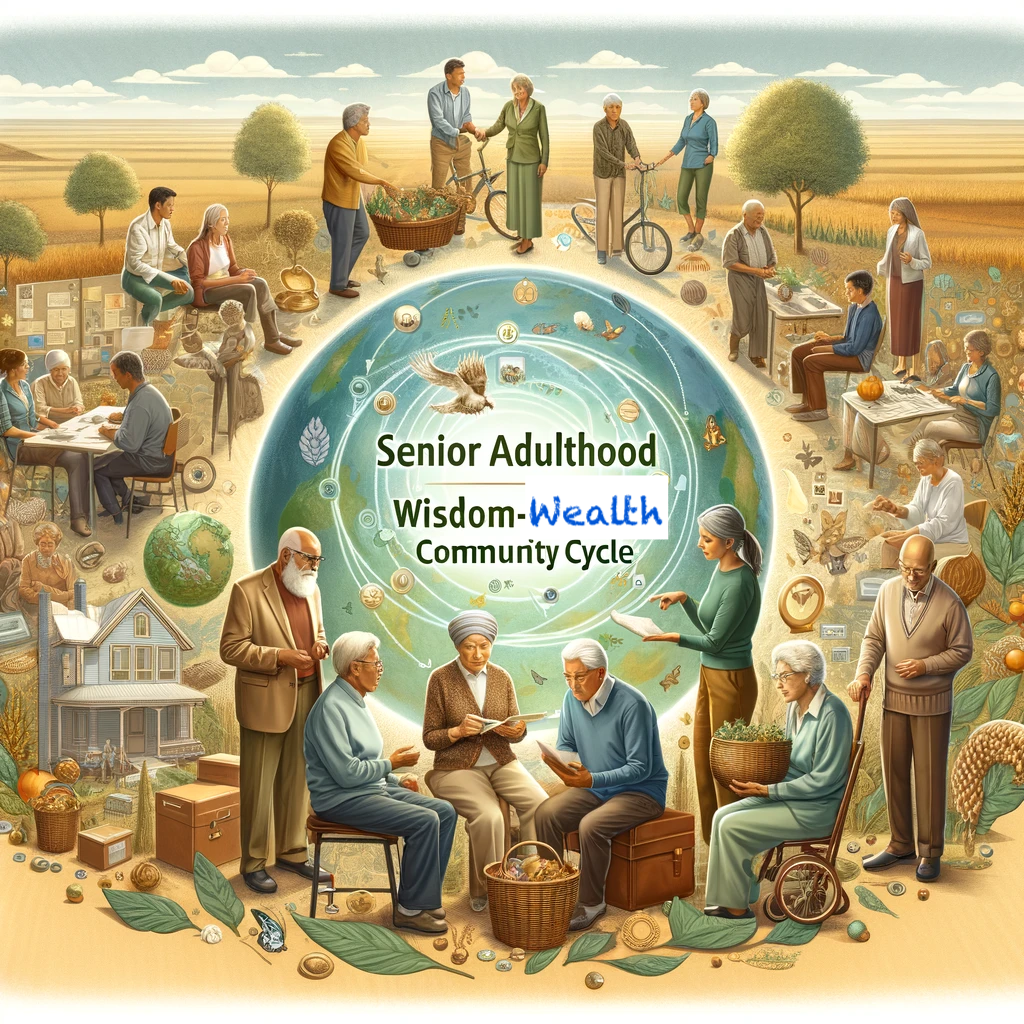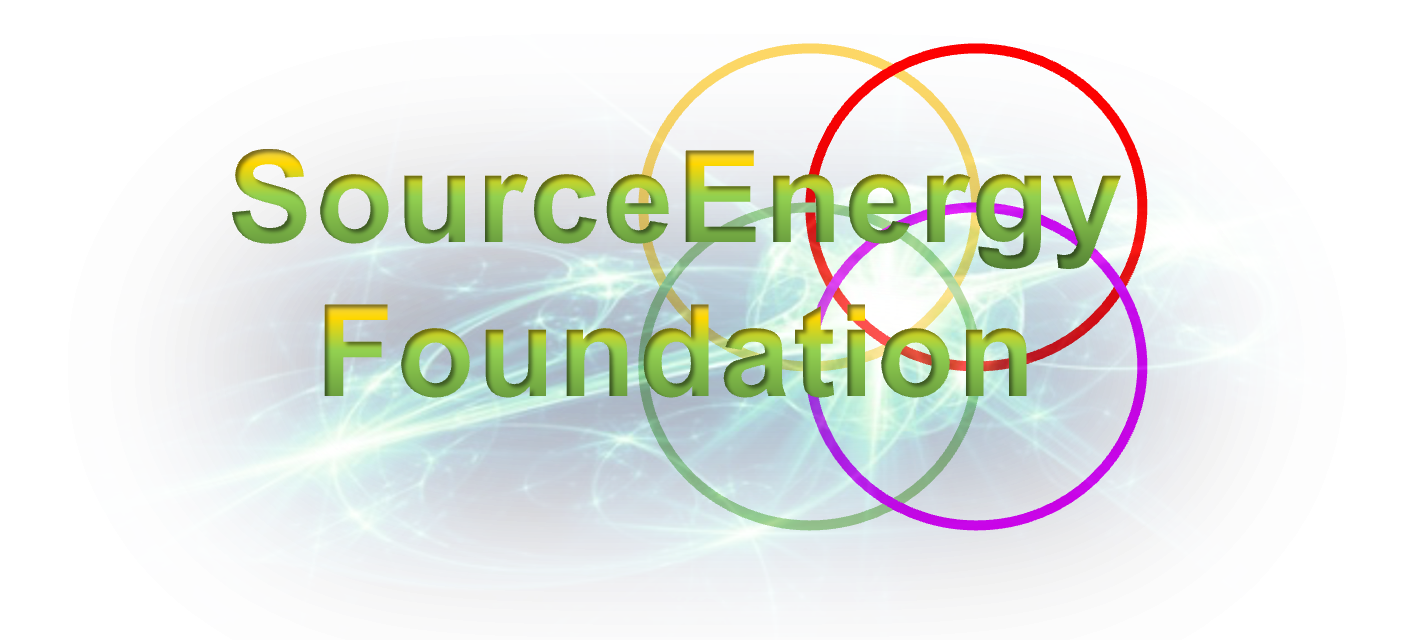Wealth Ecology Community Cycle
The Wealth Ecology Community Cycle is a framework that outlines the stages of life from birth to advanced age, emphasizing the integration of energy, technology, community, and education at each stage. This cycle reflects how individuals can contribute to and benefit from a sustainable community throughout their lives.
Creating a Wealth Ecology Community Cycle that spans various age groups and connects the elderly (ages 73-79) back to infancy (ages 0-2) involves recognizing the unique contributions and needs of each age group within a sustainable community framework. This cycle emphasizes intergenerational relationships, knowledge transfer, and the cyclical nature of support and growth within a community.
Wealth Ecology Community Cycle:
- Age 0-2 (Infancy – Foundations of Growth):1
- Focus on nurturing and early development.
- Community provides a safe and healthy environment, ensuring access to necessary resources for growth.
- Emphasis on the role of families and caregivers in early childhood development.
- Age 3-8 (Early Childhood – Exploration and Learning):2
- Stage of exploration, learning, and foundational education.
- Introduction to concepts of sustainability and community through play-based learning and early education.
- Community supports educational initiatives and fosters a sense of curiosity and connection to the environment.
- Age 9-18 (Childhood to Adolescence – Education and Identity Formation):3
- Focus on formal education, personal development, and social responsibility.
- Integration of sustainability and ethical practices into educational curriculum.
- Community engagement through youth programs, fostering a sense of belonging and responsibility.
- Age 19-32 (Young Adulthood – Innovation and Contribution):4
- Stage of higher education, career establishment, and innovation.
- Active contribution to the community through work, entrepreneurship, and civic engagement.
- Emphasis on sustainable living practices and technological advancements.
- Age 33-50 (Middle Adulthood – Leadership and Stewardship):5
- Peak of professional life, leadership roles, and community stewardship.
- Focus on mentoring younger generations and leading sustainable initiatives.
- Responsible for driving community development and implementing ethical practices.
- Age 51-72 (Senior Adulthood – Wisdom and Mentorship):6
- Stage of sharing wisdom and experiences.
- Role in mentoring and guiding younger generations, transferring knowledge and ethical values.
- Continued active engagement in community life and decision-making.
- Age 73-79 (Elderly – Legacy and Continuity):7
- Preservation of cultural heritage and legacy.
- Elders serve as living libraries, sharing life stories and lessons that enrich the community’s collective wisdom.
- Focus on leaving a sustainable and ethical legacy for future generations.
- Connecting Age 73-79 to Age 0-2 (Intergenerational Bonding):8
- Elders engage with infants and young children, fostering a sense of continuity and intergenerational connection.
- Cycle of life is celebrated, with elders playing a key role in the early development of the youngest members through storytelling, caregiving, and shared experiences.
- This connection reinforces the community’s values and the importance of each stage in life, ensuring the flow of wisdom, care, and support from one generation to the next.
Conclusion: The Wealth Ecology Community Cycle represents a holistic approach to community development, where each age group contributes uniquely to the community’s well-being. The cycle emphasizes sustainable living, education, mentorship, and intergenerational relationships, ensuring a continuous flow of knowledge, support, and ethical values from one generation to the next, fostering a thriving, sustainable community.
- Age 0-2 (Infancy – Foundations of Growth) in the Wealth Ecology Community Cycle:
Key Focus: Nurturing and Early Development
Critical Growth Phase: This stage represents the initial phase of human development, where nurturing and care are paramount. The focus is on ensuring that infants receive the necessary attention and love that are crucial for their physical, emotional, and cognitive growth.
Developmental Milestones: Attention is given to achieving developmental milestones such as emotional bonding, sensory exploration, and basic motor skills.
Community’s Role: Safe and Healthy Environment
Resource Provision: The community plays a vital role in providing a safe and healthy environment. This includes access to healthcare, nutritious food, clean water, and a pollution-free living space.
Support Systems: Community support systems, such as parenting programs, childcare facilities, and healthcare services, are established to assist families in nurturing their infants.
Emphasis on Family and Caregivers:
Family Engagement: The role of families and primary caregivers is emphasized as central to the infant’s growth and well-being. Family units are supported to ensure they can provide the best care.
Caregiver Education: Education and resources are provided to caregivers, including knowledge on infant development, nutrition, and health care, enabling them to create a nurturing environment for the infants.
Sustainable Foundations:
Building Sustainable Practices: From the earliest stages, the environment in which the infant grows is imbued with sustainable practices, such as using eco-friendly products and minimizing waste, to instill a sense of environmental stewardship.
Community Responsibility: The broader community recognizes its responsibility in contributing to the healthy development of its youngest members, understanding that a strong, sustainable future starts with the well-being of infants.
Conclusion: In the Wealth Ecology Community Cycle, the infancy stage is about laying a strong foundation for growth and development. It involves a community-wide effort to provide a nurturing, healthy environment and emphasizes the crucial role of families and caregivers. This stage sets the groundwork for sustainable living practices and instills the importance of community responsibility from the very beginning of life. ↩︎ - Age 3-8 (Early Childhood – Exploration and Learning) in the Wealth Ecology Community Cycle:
Key Focus: Exploration, Learning, and Foundational Education
Fostering Curiosity: This stage is characterized by natural curiosity and the desire to explore. Children are encouraged to learn about their world, developing foundational skills in language, mathematics, and social interaction.
Play-Based Learning: Recognizing the importance of play, education at this stage is often play-based, allowing children to learn through creative and interactive activities. This approach helps them develop critical thinking and problem-solving skills.
Introduction to Sustainability and Community Concepts:
Sustainability in Early Education: Children are introduced to basic concepts of sustainability, such as recycling, conservation of resources, and respect for nature, in an age-appropriate manner.
Community Awareness: Through stories, games, and activities, children learn about their role in the community, the importance of cooperation, and how their actions can impact the environment and those around them.
Community Support for Educational Initiatives:
Community-Driven Education: The community plays a vital role in supporting educational initiatives. This includes providing resources for schools, organizing educational events, and offering learning opportunities outside of the traditional classroom.
Involvement of Local Experts: Local experts, like environmentalists, artisans, and historians, may be involved in education, providing children with a broad and diverse learning experience.
Fostering Curiosity and Connection to the Environment:
Nature-Based Activities: Children are often engaged in outdoor and nature-based activities, helping them develop a strong connection with and appreciation for the environment.
Encouraging Inquiry and Exploration: Children are encouraged to ask questions and explore their surroundings, fostering a lifelong love of learning and discovery.
Conclusion: In the Wealth Ecology Community Cycle, the early childhood stage is a crucial period for exploration and foundational learning. It’s a time when children are introduced to the concepts of sustainability and community in a supportive, engaging, and playful environment. The community’s role in nurturing this development is vital, as it lays the groundwork for a sustainable mindset and a deepened connection to the environment and society. ↩︎ - Age 9-18 (Childhood to Adolescence – Education and Identity Formation) in the Wealth Ecology Community Cycle:
Focus on Formal Education and Personal Development:
Academic Growth: This stage marks a crucial period in formal education, where children and adolescents deepen their understanding of various subjects, including science, mathematics, literature, and social studies.
Personal Identity Formation: Adolescents begin to form their own identity, exploring personal interests, talents, and values. This period is critical for self-discovery and establishing a sense of self.
Integration of Sustainability and Ethical Practices in Education:
Sustainable Education: The educational curriculum integrates sustainability and ethical practices, teaching students about environmental conservation, social justice, and responsible citizenship.
Ethical Decision-Making: Students learn to approach problems and decisions with an ethical mindset, considering the implications of their actions on the environment and society.
Community Engagement Through Youth Programs:
Youth Involvement: Community engagement is emphasized through youth programs, clubs, and activities. These programs provide opportunities for practical involvement in community development and environmental initiatives.
Fostering Responsibility and Belonging: Active participation in community projects fosters a sense of responsibility among young people. It helps them feel connected to their community and understand the role they play in its well-being.
Development of Social Responsibility:
Civic Education: Students receive education in civic responsibility, learning about their rights and duties as community members and the importance of contributing to the common good.
Empathy and Social Awareness: Emphasis is placed on developing empathy and social awareness, encouraging students to be mindful of the needs of others and the impact of their actions on different segments of society.
Conclusion: In the Wealth Ecology Community Cycle, the childhood to adolescence stage is a time of significant growth in formal education, personal development, and social responsibility. It’s a period where sustainability and ethical practices are woven into the educational experience, fostering a deep sense of community engagement and responsibility. This stage is pivotal in shaping informed, responsible, and empathetic individuals who are prepared to contribute positively to their community and the world. ↩︎ - Age 19-32 (Young Adulthood – Innovation and Contribution) in the Wealth Ecology Community Cycle:
Stage of Higher Education, Career Establishment, and Innovation:
Pursuing Higher Education and Skill Development: This period is often characterized by higher education and the acquisition of specialized skills. Young adults pursue college degrees, vocational training, or other forms of higher learning to prepare for their careers.
Career Establishment and Innovation: As they enter the workforce, young adults are encouraged to bring innovative ideas and fresh perspectives to their fields. This is a time for creativity, experimentation, and the application of learned knowledge in practical settings.
Active Contribution to the Community:
Work and Entrepreneurship: Young adults contribute to the community through their work, whether in private businesses, public services, or non-profit organizations. Entrepreneurship is encouraged, especially in areas that promote sustainability and social welfare.
Civic Engagement: Active participation in civic life is emphasized. This includes involvement in local governance, community projects, and advocacy initiatives, fostering a sense of responsibility and commitment to societal well-being.
Emphasis on Sustainable Living Practices and Technological Advancements:
Adoption of Sustainable Living: This age group is at the forefront of adopting and advocating for sustainable living practices. They integrate principles of sustainability into their daily lives, from choices in housing and transportation to consumption and waste management.
Leveraging Technology for Sustainability: Young adults are often more attuned to technological advancements and are positioned to leverage technology in ways that promote environmental sustainability and improve quality of life. This includes innovations in renewable energy, sustainable agriculture, and digital technology for social good.
Conclusion: In the Wealth Ecology Community Cycle, the young adulthood stage is a dynamic period of innovation, contribution, and establishment in both personal and professional spheres. It is marked by a strong emphasis on higher education, career development, community engagement, and the integration of sustainable practices. This age group plays a crucial role in driving societal progress and implementing sustainable solutions, setting the stage for a future that aligns with the principles of environmental stewardship, technological advancement, and community well-being. ↩︎ - Age 33-50 (Middle Adulthood – Leadership and Stewardship) in the Wealth Ecology Community Cycle:
Peak of Professional Life, Leadership Roles, and Community Stewardship:
Professional Growth and Leadership: Individuals in this age group are often at the peak of their professional careers. They assume leadership roles in various sectors, leveraging their experience and expertise to influence and guide others.
Active Role in Community Stewardship: Middle adulthood is characterized by a heightened sense of responsibility towards the community. Individuals take active roles in stewarding community resources, planning sustainable development, and preserving the community’s cultural and environmental heritage.
Focus on Mentoring Younger Generations:
Mentorship and Guidance: Individuals in this age group often take on mentorship roles, passing on knowledge, skills, and values to younger generations. This mentorship is crucial for preparing future leaders and ensuring the continuity of sustainable practices.
Role Models for Sustainability: As mentors, they are role models who demonstrate how to balance professional responsibilities with a commitment to sustainability and ethical living.
Leading Sustainable Initiatives:
Driving Sustainable Projects: Middle-aged adults are often at the forefront of initiating and leading sustainable projects, whether in their workplaces, local communities, or larger-scale environmental initiatives.
Innovative Solutions for Sustainability: They utilize their accumulated knowledge and resources to develop and implement innovative solutions that address environmental, social, and economic challenges.
Responsibility for Community Development and Ethical Practices:
Community Development Leaders: This age group plays a key role in driving community development efforts. They are involved in planning and executing projects that enhance the quality of life for community members while ensuring sustainability.
Upholding and Implementing Ethical Practices: There is a strong emphasis on maintaining high ethical standards in all endeavors. This includes ethical business practices, responsible resource management, and fair and inclusive community policies.
Conclusion: In the Wealth Ecology Community Cycle, middle adulthood is a phase of leadership and stewardship, where individuals leverage their experience and influence to benefit both their professional fields and communities. This stage is marked by a commitment to mentoring, leading sustainable initiatives, and actively participating in community development. Individuals in this age group are crucial in shaping a sustainable future, as they implement and model practices that balance economic growth with environmental stewardship and social responsibility. ↩︎ - Age 51-72 (Senior Adulthood – Wisdom and Mentorship) in the Wealth Ecology Community Cycle:
Stage of Sharing Wisdom and Experiences:
Rich Repository of Knowledge: Senior adults in this age range are seen as valuable repositories of wisdom and experience. Having lived through various phases of life, they offer unique insights and perspectives that are invaluable to their communities.
Narratives and Life Lessons: This stage is characterized by the sharing of life stories, experiences, and lessons learned, contributing to the community’s collective wisdom and historical understanding.
Role in Mentoring and Guiding Younger Generations:
Intergenerational Mentorship: Senior adults play a crucial role in mentoring and guiding younger generations. They transfer not only professional knowledge and skills but also impart ethical values and sustainable living practices.
Guidance in Personal and Professional Development: Their mentorship encompasses various aspects of life, from career guidance and personal development to navigating complex life decisions and fostering sustainable habits.
Continued Active Engagement in Community Life and Decision-Making:
Active Participation in Community Affairs: Despite advancing in age, senior adults remain actively engaged in community life. They participate in cultural events, community discussions, and local governance, bringing their wisdom to bear on communal issues.
Influential Voices in Decision-Making: Their experience and wisdom make them influential voices in community decision-making processes. They often serve on councils, boards, and committees, helping to shape policies and initiatives that impact the community.
Conclusion: In the Wealth Ecology Community Cycle, senior adulthood is a period marked by wisdom, mentorship, and continued active engagement in community life. Individuals in this age group are crucial for transferring knowledge, ethical values, and sustainable practices to younger generations. Their involvement in community life and decision-making processes ensures that the community benefits from their accumulated experiences and insights, fostering a rich intergenerational exchange that strengthens the community’s sustainability and resilience. ↩︎ - Elders Engaging with Infants and Young Children:
Fostering Continuity and Connection: Elders in the age group of 73-79 play a special role in connecting with the youngest members of the community, infants and toddlers aged 0-2. This engagement fosters a deep sense of continuity and intergenerational bonding.
Role in Early Development: Through their interactions, elders contribute significantly to the early development of these young children. Their involvement can range from informal caregiving to structured activities like storytelling, singing, and gentle play.
Celebrating the Cycle of Life:
Elders as Key Contributors: Elders are seen as key contributors to the nurturing environment of the youngest generation. Their presence and participation in the lives of infants and young children are a celebration of the cycle of life, symbolizing the passing of wisdom and culture from one generation to the next.
Shared Experiences and Learning: Through shared experiences, both the elders and the young children benefit. While the children learn from the elders’ experiences and stories, the elders find joy and renewed purpose in their interaction with the young ones.
Reinforcing Community Values and the Importance of Life Stages:
Transmission of Values: This intergenerational connection is a vital channel for transmitting the community’s core values, traditions, and beliefs. Elders impart these values through their stories, actions, and the wisdom they share.
Understanding of Life Stages: The interaction between the oldest and youngest members of the community helps reinforce the importance and value of each stage in life. It highlights the continuous flow of wisdom, care, and support that moves through the community, binding its members together.
Conclusion: In the Wealth Ecology Community Cycle, connecting elders aged 73-79 with children aged 0-2 represents a beautiful synthesis of the cycle of life. This intergenerational bonding is crucial for fostering a sense of community continuity, transmitting values, and celebrating the contributions of each age group. It ensures that the wisdom and experience of the elder generation are passed down, nurturing the growth and development of the youngest members, and reinforcing the community’s commitment to its core values and sustainable practices. ↩︎ - Connecting Age 73-79 to Age 0-2 (Intergenerational Bonding) in the Wealth Ecology Community Cycle:
Elders Engaging with Infants and Young Children:
Fostering Continuity and Connection: Elders aged 73-79 engage with infants and young children, creating a bridge between the oldest and youngest generations. This interaction fosters a profound sense of continuity and strengthens intergenerational bonds within the community.
Contributing to Early Development: Elders play a vital role in the early development stages of these young children. Their involvement often includes storytelling, caregiving, and sharing rich life experiences, which contribute to the children’s emotional and cognitive development.
Celebrating the Cycle of Life:
Elders as Custodians of Tradition: The elders’ involvement in the lives of the youngest members symbolizes the celebration of the cycle of life. They act as custodians of tradition and wisdom, ensuring the continuity of the community’s heritage and values.
Mutually Enriching Experiences: The interaction is mutually enriching, providing joy and a sense of purpose to the elders while offering love, attention, and valuable life lessons to the children.
Reinforcing Community Values and Life Stages:
Transmission of Wisdom and Values: This intergenerational connection serves as an essential conduit for transmitting the community’s core values, traditions, and wisdom, embedding these principles in the new generation from an early age.
Understanding and Valuing All Life Stages: The relationship between the oldest and youngest members helps reinforce the importance and significance of each stage in life within the community. It highlights a continuous flow of wisdom, care, and support that binds the community across generations.
Conclusion: In the Wealth Ecology Community Cycle, the connection between elders aged 73-79 and children aged 0-2 is integral to maintaining the fabric of the community. It ensures that the wisdom, care, and cultural heritage of the elder generation are lovingly passed down to the youngest members, fostering a strong sense of identity, continuity, and intergenerational solidarity. This bonding is essential in reinforcing the community’s values and the importance of each stage in life, thereby sustaining a cohesive and resilient community ecosystem.
Building a Sustainable Future Through Intergenerational Bonding:
Integrating Elders into Early Childhood Education:
Active Participation in Educational Settings: Elders can be integrated into early childhood education programs, where their presence adds a unique dimension to the learning environment. By participating in activities at nurseries or schools, they can engage directly with the children, sharing stories, skills, and knowledge.
Bridging the Generational Gap: This involvement not only benefits the children through exposure to diverse experiences and perspectives but also helps bridge the generational gap, fostering mutual understanding and respect.
Community Events and Family Gatherings:
Inclusive Social Activities: Community events and family gatherings are ideal platforms for fostering intergenerational bonding. Activities that cater to all ages encourage participation from both elders and young children, facilitating interaction and shared experiences.
Celebrating Heritage and Culture: These gatherings are opportunities to celebrate the community’s heritage, where elders can share cultural traditions, history, and stories, enriching the community’s collective memory and identity.
Mentoring and Nurturing Roles:
Elders as Mentors and Caregivers: Elders can take on informal mentoring and nurturing roles, providing guidance, care, and support to young families. This can range from offering parenting advice to babysitting, creating a supportive network for young parents.
Fostering Emotional Bonds: These roles allow for the development of strong emotional bonds between the generations, creating a sense of extended family and community cohesion.
Documenting and Sharing Life Stories:
Recording Histories and Experiences: Encouraging elders to document and share their life stories and experiences can be a valuable resource for both current and future generations. This can be done through written memoirs, recorded interviews, or storytelling sessions.
Learning from the Past: Such initiatives provide children with a window into the past, helping them understand their heritage and the experiences that have shaped their community. It’s a way of learning from the past to inform the future.
Conclusion: The connection between elders aged 73-79 and children aged 0-2 in the Wealth Ecology Community Cycle is a fundamental aspect of building a sustainable and resilient community. By fostering intergenerational bonding, the community ensures the flow of wisdom, values, and support across generations. This bonding nurtures a sense of belonging, continuity, and shared responsibility, vital for sustaining a community that is rooted in its past yet looking towards the future with hope and wisdom.
Creating a Legacy of Sustainability and Community Values:
Legacy and Environmental Stewardship:
Imparting Environmental Values: Elders play a crucial role in imparting values of environmental stewardship to the youngest members of the community. Through their interactions, they can instill an early appreciation for nature and the importance of sustainable living.
Legacy of Conservation: By sharing their experiences and wisdom about the environment, elders can leave a legacy of conservation, ensuring that future generations are aware of and committed to preserving the natural world.
The Role of Technology in Bridging Generations:
Digital Storytelling and Sharing: Utilizing technology, elders can bridge the generational divide by sharing their life stories, experiences, and lessons through digital storytelling platforms, creating a lasting and accessible record.
Facilitating Intergenerational Communication: Technology can also be used to facilitate communication between elders and young children, especially in communities where families are physically distant. Virtual interactions can help maintain these important connections.
Promoting Health and Well-being Across Generations:
Shared Activities for Physical Health: Intergenerational activities, such as gardening, walking, or gentle exercises, can promote physical health for both elders and young children, creating opportunities for them to learn from and motivate each other.
Emotional and Mental Well-being: The emotional bonds formed through these interactions are beneficial for the mental and emotional well-being of both age groups, offering companionship to the elderly and a sense of security and love to the children.
Community Initiatives for Intergenerational Interaction:
Intergenerational Programs and Centers: Communities can establish programs and centers dedicated to intergenerational interaction. These can range from shared community gardens to arts and crafts workshops, where both elders and young children can participate and learn from each other.
Celebrating Intergenerational Day: Designating a community-wide intergenerational day to celebrate the unity and diversity of ages can reinforce the importance of these relationships, encouraging widespread participation and awareness.
Conclusion: In the Wealth Ecology Community Cycle, fostering a connection between elders aged 73-79 and children aged 0-2 is a pivotal aspect of building a sustainable and cohesive community. This intergenerational bonding not only ensures the transfer of wisdom and values but also strengthens the community’s commitment to environmental stewardship, health, and well-being. Through various initiatives and the use of technology, communities can create rich, intergenerational experiences that benefit all members and contribute to a legacy of sustainability, community values, and mutual care. ↩︎
